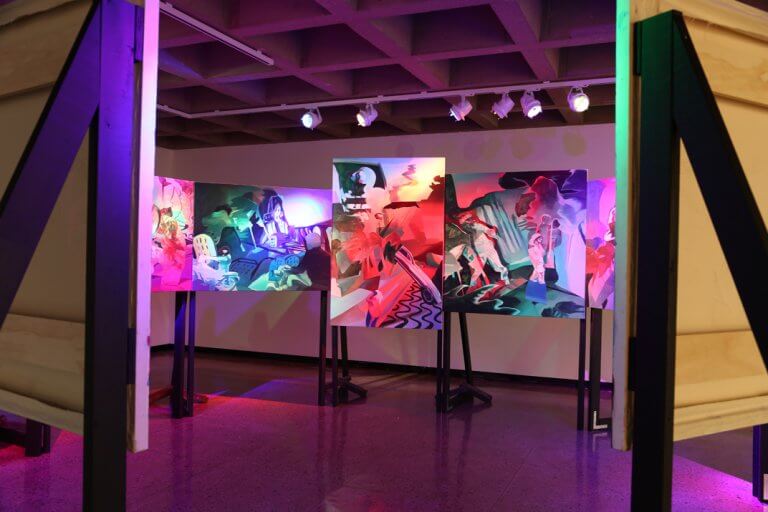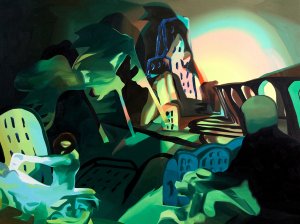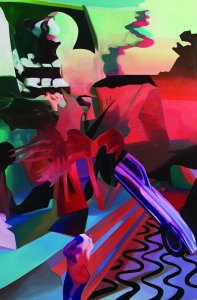
Jessica Mensch: Chromatrope

One approaches Chromatrope in the dark, as if from behind a theatrical set that faces internally, and thus seems to delimit two sorts of experience, one openly contingent and constructed, and one totalizing and absorptive. Once inside the installation’s circular internal space, however, the situation becomes more complicated. Jessica Mensch’s series of paintings, illuminated by changing, theatrically coloured lights, represent a superheated, dreamlike world that suggests a tropical demimonde, a summer evening of luxurious, but perhaps slightly poisonous and excessive colours. These are illusionary and fantastic pictures, featuring figures and settings that drift in and out of credibility, like dreams or myths.

The installation sets up a tension between the contrary demands of painting, and arguably of art in general, those of revelation and illusion. On the one hand, the means of image making are explicitly on display, from the wooden, painted structures that hold a series of pictures in view, at eye level, to the areas of paint that drift in and out of focus as the lights change, alternating from flat, abstract fields of colour to shaded delineations of volume, both of things depicted, and the spaces they occupy. The devices of illusion, the mechanics of painting and its presentation in the artificial space of the gallery, are laid out for us to see. The lighting looks like “lighting,” a child of the representational apparatus of theatre. At the same time, the paintings propose a mythic world with a vividness and immediacy that overwhelms both conceptual abstraction—the resting point of many painters who like to reveal the means of painting—and the “realism” of the installation’s material and object quality. The figures and settings of Chromatrope draw us into an illusionary place and time, even if they fail to cohere fully into conventional narrative or spatial consistency.
The paintings are based on miniature theatrical sets, their compositional structure derived from the lighting, costumes, and backdrops of performances and videos by Inflatable Deities—an ongoing collaborative project between Mensch and artist Emily Pelstring. The decisions that make up an immersive event, as much as those that build a static painting, are embedded in the resulting pictures, which follow the logic of a dreamlike performance. And the figures are characters; they play narrative and symbolic roles. The same is true of the vaguely filmic settings. Overt references to cultural continuity, to mythic structures, from the Greek temple to fabulistic characters such as the predatory “wolfman,” live alongside figures of mobility and transience, like the streamlined car that appears in, and disrupts, one painting as a fragment both of the moving image and the fragility of constructed space. In Chromatrope, the theatrically illuminated night is a place of shifting identities: changing colours, liquids and solids, places that are both real and symbolic, and marauding, seductive beings whose desires and fears are unleashed. Invention opens both a space of freedom and a circular, trancelike nightmare of recurring archetypes.
Pan Wendt, Curator
